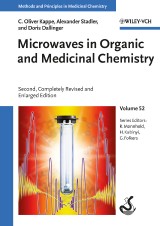Details

Microwaves in Organic and Medicinal Chemistry
Methods & Principles in Medicinal Chemistry, Band 52 2nd Completely Revised and Enlarged Edition
|
198,99 € |
|
| Verlag: | Wiley-VCH |
| Format: | |
| Veröffentl.: | 27.03.2012 |
| ISBN/EAN: | 9783527647859 |
| Sprache: | englisch |
| Anzahl Seiten: | 683 |
DRM-geschütztes eBook, Sie benötigen z.B. Adobe Digital Editions und eine Adobe ID zum Lesen.
Beschreibungen
Tailored to the needs of medicinal and natural products chemists, the second edition of this unique handbook brings the contents up to speed,<br> almost doubling the amount of chemical information with an additional volume.<br> As in the predecessor, a short introductory section covers the theoretical background and evaluates currently available instrumentation and<br> equipment. The main part of the book then goes on to systematically survey the complete range of published microwave-assisted synthesis<br> methods from their beginnings in the 1990s to mid-2011, drawing on data from more than 5,000 reports and publications. Throughout, the<br> focus is on those reactions, reagents and reaction conditions that work, and that are the most relevant for medicinal and natural products<br> chemistry. A much expanded section is devoted to combinatorial, highthroughput and flow chemistry methods.
PPREFACE<br> <br> INTRODUCTION: MICROWAVE SYNTHESIS IN PERSPECTIVE<br> Microwave Synthesis and Medicinal Chemistry<br> Microwave-Assisted Organic Synthesis (MAOS): A Brief History <br> Scope and Organization of the Book<br> <br> MICROWAVE THEORY<br> Microwave Radiation<br> Microwave Dielectric Heating<br> Dielectric Properties<br> Microwave versus Conventional Thermal Heating<br> Microwave Effects<br> <br> EQUIPMENT REVIEW<br> Introduction<br> Domestic Microwave Ovens<br> Dedicated Microwave Reactors for Organic Synthesis<br> Single-Mode Instruments<br> Multimode Instruments<br> <br> MICROWAVE PROCESSING TECHNIQUES<br> Solvent-Free Reactions<br> Phase-Transfer Catalysis<br> Open- versus Closed-Vessel Conditions<br> Pre-pressurized Reaction Vessels<br> Nonclassical Solvents<br> Passive Heating Elements<br> Processing Techniques in Drug Discovery and High-Throughput Synthesis<br> Scale-Up in Batch and Continuous Flow<br> <br> LITERATURE SURVEY PART A: TRANSITION METAL-CATALYZED REACTIONS<br> General Comments<br> Carbon?Carbon Bond Formations<br> Carbon?Heteroatom Bond Formations<br> Other Transition Metal-Mediated Processes<br> <br> LITERATURE SURVEY PART B: MISCELLANEOUS ORGANIC<br> Transformations<br> Rearrangement Reactions<br> Cycloaddition Reactions<br> Oxidations<br> Reductions and Hydrogenations<br> Mitsunobu Reactions<br> Glycosylation Reactions and Related Carbohydrate-Based Transformations<br> Organocatalytic Transformations<br> Organometallic Transformations (Mg, Zn, and Ti)<br> Multicomponent Reactions<br> Alkylation Reactions<br> Nucleophilic Aromatic Substitutions<br> Ring-Opening Reactions<br> Addition and Elimination Reactions<br> Substitution Reactions<br> Enamine and Imine Formations<br> Reductive Aminations<br> Ester and Amide Formation<br> Decarboxylation Reactions<br> Free Radical Reactions<br> Protection/Deprotection Chemistry<br> Preparation of Isotopically Labeled Compounds<br> Miscellaneous Transformations<br> <br> 7 LITERATURE SURVEY PART C: HETEROCYCLE SYNTHESIS<br> Three-Membered Heterocycles with One Heteroatom<br> Four-Membered Heterocycles with One Heteroatom<br> Five-Membered Heterocycles with One Heteroatom<br> Five-Membered Heterocycles with Two Heteroatoms<br> Five-Membered Heterocycles with Three Heteroatoms<br> Five-Membered Heterocycles with Four Heteroatoms<br> Six-Membered Heterocycles with One Heteroatom<br> Six-Membered Heterocycles with Two Heteroatoms<br> Six-Membered Heterocycles with Three Heteroatoms<br> Larger Heterocyclic and Polycyclic Ring Systems<br> <br> LITERATURE SURVEY PART D: COMBINATORIAL CHEMISTRY AND HIGH-THROUGHPUT ORGANIC SYNTHESIS<br> Solid-Phase Organic Synthesis<br> Soluble Polymer-Supported Synthesis<br> Fluorous-Phase Organic Synthesis<br> Grafted Ionic Liquid-Phase-Supported Synthesis<br> Polymer-Supported Reagents<br> Polymer-Supported Catalysts<br> Polymer-Supported Scavengers<br> <br>
C. Oliver Kappe is Professor of organic chemistry and Director of the Doppler Laboratory for Microwave Chemistry at the University<br> of Graz, Austria, where he also received his doctorate in 1992. After postdoctoral work with CurtWentrup at the University of Queensland, Australia, and with Albert Padwa at Emory University, Atlanta, USA, he returned to the University of Graz and became Associate Professor in 1999. He has been a visiting scientist at the Scripps Research Institute as well as the Tokyo Institute of Technology. Professor Kappe's current research focuses on microwave-assisted synthesis and continuous flow processing.<br> <br> Alexander Stadler studied chemistry at the University of Graz, Austria, where he also obtained his doctoral degree for studies on microwave-accelerated reactions in solution and on solid phase in the group of C. Oliver Kappe. He conducted postdoctoral research work on microwave-assisted transition metal-catalyzed coupling reactions in the group of Mats Larhed at the University of Uppsala, Sweden. In 2004 he joined Anton Paar GmbH in Graz where he is currently working as product manager for microwave synthesis instruments.<br> <br> Doris Dallinger obtained her PhD degree in the group of C. Oliver Kappe at the University of Graz, Austria, on projects related to microwave chemistry and high-throughput synthesis. After postdoctoral research work at the Christian Doppler Laboratory for Microwave Chemistry she joined the faculty of the University of Graz as staff scientist in 2011.
Tailored to the needs of medicinal and natural products chemists, the second edition of this unique handbook brings the contents up to speed,<br> almost doubling the amount of chemical information with an additional volume.<br> As in the predecessor, a short introductory section covers the theoretical background and evaluates currently available instrumentation and<br> equipment. The main part of the book then goes on to systematically survey the complete range of published microwave-assisted synthesis<br> methods from their beginnings in the 1990s to mid-2011, drawing on data from more than 5,000 reports and publications. Throughout, the<br> focus is on those reactions, reagents and reaction conditions that work, and that are the most relevant for medicinal and natural products<br> chemistry. A much expanded section is devoted to combinatorial, highthroughput and flow chemistry methods.


















